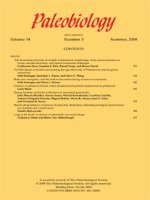Clymeniid ammonoids appeared during the Late Devonian (Mid-Famennian) and quickly radiated before becoming extinct at the Devonian/Carboniferous boundary. Outwardly indistinguishable from other ammonoids, clymeniids are distinguished internally by their dorsal siphuncle, contrasted to a ventral siphuncle in almost all other ammonoids. Comparisons of a sample of Clymeniida (n = 22 genera), Goniatitida (n = 33), Prolecanitida (n = 12), and Anarcestida (n = 13) indicate that clymeniids fall within the range of other ammonoids in terms of shell geometry and suture complexity, but their siphuncles average two to three times larger and clymeniid shells are approximately 33% thicker than those of other ammonoids. Although a dorsal siphuncle would be about 50% smaller in surface area and volume than if located in a ventral position, the enlarged clymeniid siphuncle partially and, in some cases, fully compensated for this loss. Hydrostatic simulations of 15 clymeniid genera indicate that their thicker (therefore heavier) shells would have resulted in relatively short body chambers (≈280°) and high aperture orientations (≈90°). In static life-position, these orientations would have placed the dorsal clymeniid siphuncle at or near the bottom of the most recently formed chambers, seemingly an ideal location for draining liquid from the chamber. Migration of the siphuncle to the dorsal side of the shell occurs suddenly during early ontogeny (within the first two or three chambers), and mutation of homeotic gene expression is offered as a possible explanation for the sudden shift. A dorsal siphuncle may have resulted in selection for enlarged siphuncles, but this may have incurred loss of strength against hydrostatic pressure (thereby reducing depth limits) and thus rendered the clade more susceptible to the multiple eustatic and anoxic events that marked the end of the Devonian.
How to translate text using browser tools
1 June 2005
The clymeniid dilemma: functional implications of the dorsal siphuncle in clymeniid ammonoids
William E. Gottobrio,
W. Bruce Saunders
ACCESS THE FULL ARTICLE





